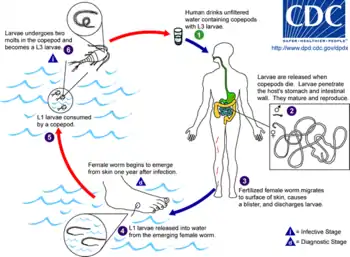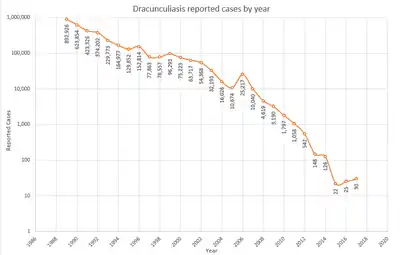Dracunculus (nematode)
Dracunculus is a genus of spiruroid nematode parasites in the family Dracunculidae. Some species infest humans and alter their hosts’ behaviour in a way that supports the worm's reproductive cycle. Dracunculus causes a blister to form on the host, often on the foot or lower leg, causing severe pain and a boiling sensation. This will cause the human host to dip the affected area in water to soothe the pain which will cause the blister to burst, allowing reproductive larvae into the water where they can await the next host to infect.
| Dracunculus | |
|---|---|
 | |
| Dracunculus medinensis larvae | |
| Scientific classification | |
| Kingdom: | Animalia |
| Phylum: | Nematoda |
| Class: | Secernentea |
| Order: | Camallanida |
| Family: | Dracunculidae |
| Genus: | Dracunculus |
| Species | |
|
Dracunculus alii | |
The worms can reach a metre in length. If one simply pulls off the protruding head of the worm, the worm will break and leak high levels of foreign antigen which can lead to anaphylactic shock and fast death of the host. Hence it is important to remove the worm slowly (over a period of weeks). This is typically undertaken by winding the worm onto a stick (say, a matchstick), by a few centimetres each day.
Species
D. medinensis and D. insignis

The best known species is D. medinensis, known commonly as the Guinea worm. This parasite is frequently found in the subcutaneous tissues and muscles of humans, dogs, and sometimes cattle and horses. The medical name for this condition is dracunculiasis. The disease causes cutaneous nodules and subsequent ulcers. The anterior end of the adult female worm protrudes from the host animal's body, most commonly on a lower limb, through an ulcer. When the worm feels the presence of cold water, muscle contractions in its body cause its uterus (which fills the whole body cavity) to burst, releasing hundreds of thousands of first-stage larvae into the water, where they can find new hosts.[1]
D. insignis infects dogs and wild carnivores, causing cutaneous lesions, ulcers, and sometimes heart and vertebral column lesions. Like D. medinensis, it is also known as Guinea worm, as well as Dragon or Fiery Dragon. The range of D. insignis is limited to North America.
DNA fingerprinting can differentiate between D. medinensis and D. insignis, which is important to efforts to eradicate dracunculiasis.[2]
Distribution and eradication
The eradication effort began in 1986 due to around 3.5 million cases being confirmed in African and Asian countries by the Carter Center and other health organizations.[3][4] Since then, the number of cases has been drastically decreasing.
| year | total cases | % |
|---|---|---|
| 2009 | 2463 | NA |
| 2010 | 1785 | 38% |
| 2011 | 1006 | 77% |
| 2012 | 521 | 96% |
In 2011 only four countries still had the human-infecting Dracunculus medinensis – and of these, Ghana, Ethiopia and Mali have nearly eliminated it. Of the 1785 cases found in 2010, 1690 were in south Sudan, which is 38 per cent fewer than the number of cases in 2009.[5] In January 2013, the World Health Organization reported finding only 521 cases between January and September 2012.[6]

A major problem in the eradication effort comes from the increased number of dog infections in Chad. As of June 2019, this country has the highest number of cases in the world, 96% of which are from dog infections. However, countries like Mali have reported no human cases for 3.5 years and Ethiopia has no reported human cases for 1.5 years. The effort to eradicate infections has focused mainly stopping the helminth at various points in its life cycle. Preventative measures focus on educating people on the importance of cooking fish thoroughly and preventing other animals from eating discarded portions of the fish. Other measures consist of not allowing reentry into the water from infected individuals. This means keeping infected dogs tied up and away from water and preventing infected people from dipping their appendages in water. Chad even gave monetary incentives for took these steps in confirmed dog or human infections. [7]
Life cycle
The life cycle was elucidated in 1870 when Alexei Pavlovich Fedchenko of Russia discovered the copepod crustacean intermediate host. The life cycle of Dracunculus medinensis has been show to have multiple life stages. Ingestion of infected copepods starts the life cycle in a human host. They then reproduce and grow inside the human for around a year until they burst from a blister on the leg of the host. They then reach water where they can go on to infect more copepods to start the cycle again. They may also be transmitted from ingestion of fish or amphibians that have eaten infected copepods. Other animals may also be infected by Dracunculus medinensis[8]
Rod of Asclepius
It has been suggested that the Rod of Asclepius (the symbol which represents medical practice since ancient times) once represented a worm wrapped around a rod; parasitic worms such as the guinea worm (Dracunculus medinensis) were common in ancient times, and were extracted from beneath the skin by winding them slowly around a stick. According to this theory, physicians might have advertised this common service by posting a sign depicting a worm on a rod. However plausible, no concrete evidence in support of this theory has been adduced.[9]
See also
- Dracunculiasis
- List of parasites (human)
- Planned extinction
References
- Ruiz-Tiben E, Hopkins DR (2006). "Dracunculiasis (Guinea worm disease) eradication". Advances in Parasitology. 61: 275–309. doi:10.1016/S0065-308X(05)61007-X. ISBN 9780120317615. PMID 16735167.
- Bimi L, Freeman AR, Eberhard ML, Ruiz-Tiben E, Pieniazek NJ (July 2005). "Differentiating Dracunculus medinensis from D. insignis, by the sequence analysis of the 18S rRNA gene" (PDF). Annals of Tropical Medicine and Parasitology. 99 (5): 511–7. CiteSeerX 10.1.1.603.9521. doi:10.1179/136485905x51355. PMID 16004710.
- Watts SJ (July 1987). "Dracunculiasis in Africa in 1986: its geographic extent, incidence, and at-risk population". The American Journal of Tropical Medicine and Hygiene. 37 (1): 119–25. doi:10.4269/ajtmh.1987.37.119. PMID 2955710.
- "WHO | Dracunculiasis eradication: global surveillance summary, 2017". WHO. Retrieved 2020-02-27.
- MacKenzie D (14 January 2011). "Southern Sudan's votes could kill an ancient disease". New Scientist. Retrieved 6 February 2017.
- Thomas G, Moloo A (16 January 2013). "WHO heralds "new phase" in the fight against neglected tropical diseases". world Health Organisation. Retrieved 6 February 2017.
- Hopkins DR, Weiss AJ, Roy SL, Zingeser J, Guagliardo SA (November 2019). "Progress Toward Global Eradication of Dracunculiasis - January 2018-June 2019". MMWR. Morbidity and Mortality Weekly Report. 68 (43): 979–984. doi:10.15585/mmwr.mm6843a5. PMC 6822808. PMID 31671082.
- "CDC - Guinea Worm Disease - Biology". CDC-Centers for Disease Control and Prevention. 2019-04-17. Retrieved 2020-02-17.
- Emerson J (27 July 2003). "Eradicating Guinea Worm Disease". Social Design Notes. Retrieved 6 February 2017.
External links
- "Dracunculus". Integrated Taxonomic Information System. Retrieved 6 February 2017.